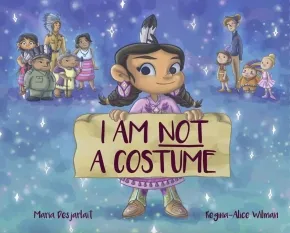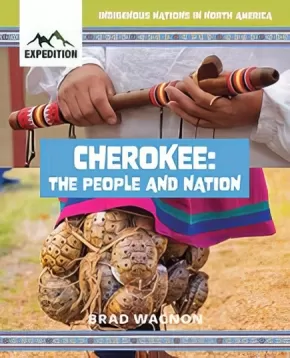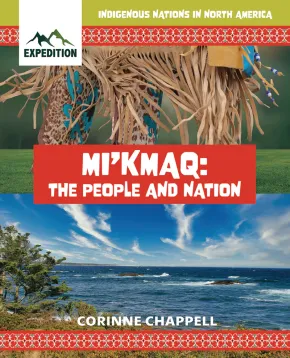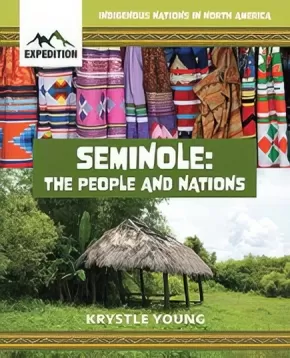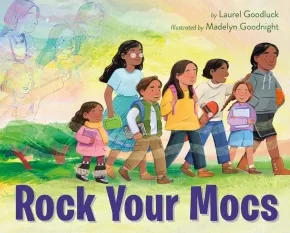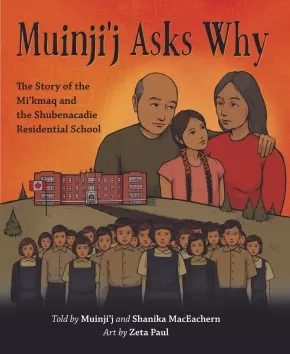
Indigenous Culture / Identity
1
-
15
of
56 Results;
Sort By
Go To
of 4
Anishinaabek: The People and Nations
$17.95
Format:
Paperback
Text Content Territories:
Indigenous Canadian; First Nations; Anishinaabeg;
ISBN / Barcode: 9781774565100
Synopsis:
Synopsis:
The Anishinaabek are a rich nation with teachings and practices passed down from generation to generation. Explore more about the people and nations through Anishinaabek author Jennifer Meness.
Educator & Series Information
This book is part of the Indigenous Nations in North America series.
Additional Information
32 Pages | Paperback
Celebrating Potlatches
$21.95
Artists:
Format:
Hardcover
Text Content Territories:
Indigenous Canadian; First Nations; Tsimshian (Ts'msyen); Nisga'a;
ISBN / Barcode: 9781771746564
Synopsis:
Synopsis:
“Papa, what is a Potlatch?”
Inspired by Ts’msyen Chief William Beynon’s historic notebooks on Potlatches in the Gitxsan village of Gitsegukla, Celebrating Potlatches pairs intergenerational storytelling with beautiful illustrations to honour Indigenous traditions. From the award-winning author of Oolichan Moon and the accomplished illustrator of Be a Good Ancestor, this book recounts the 1885 Potlatch ban and the resilience of the communities who fought to keep their traditions alive.
Reviews
“Heartfelt and timely, Celebrating Potlatches gifts readers with cultural teachings through an intergenerational account of Indigenous resilience. This book is a beautiful tribute to the author’s great-grandfather, William Beynon, whose life’s work documenting oral histories of Sm’algya̱x-speaking Peoples and their Potlatches continues to be foundational to our cultural resurgence today.” – Sm Łoodm ‘Nüüsm (Dr. Mique’l Dangeli), Sm’algya̱x language expert and Assistant Professor of Indigenous Arts at the University of Victoria
“This beautiful book shares the importance of community, culture, and identity. As you make your way through the pictures and words, they bring you to an understanding of how important the Potlatch ceremony was and continues to be for Indigenous Peoples.” – Carolyn Roberts, educator, speaker, and author of Re-Storying Education
Educator Information
Recommended for ages 4 to 8.
Through this conversational historic account, readers can learn alongside the narrator as his Papa shares his wisdom about the rich history of the Potlatch.
Curriculum Connections
- Early literacy – listening, reading, and discussing
- Art – traditional Indigenous art, drumming, and regalia
- Social studies – the 1885 Potlatch ban, history of Indigenous Peoples, connection to community
- Social responsibility – uplifting ourselves and others, honouring traditions
- Indigenous knowledge and traditions – traditional teachings, Potlatch ceremonies, intergenerational storytelling
Two free, downloadable lesson plans—one for kindergarten to Grade 1 and one for Grades 2 to 3—provide connections to Social Studies curriculum.
Additional Information
32 Pages | 10" x 8.5" | Hardcover
I Am Not a Costume
$22.99
Artists:
Format:
Hardcover
Text Content Territories:
Indigenous American; Native American; Anishinaabeg; Ojibwe (Chippewa);
ISBN / Barcode: 9781778540738
Synopsis:
Synopsis:
I am not a costume.
Ayasha’s school is having a costume party and she is so excited!
But when Ayasha arrives at school and sees other students wearing fake regalia, she is confused and upset. She doesn’t understand why they think her culture is a costume. Ayasha turns to her family and together they come up with a way to teach her classmates about her culture and how to honor her people respectfully.
Educator Information
Recommended for ages 6+.
Additional Information
32 pages | 8.50" x 11.00" | Hardcover
Cherokee: The People and Nation
$16.95
Format:
Paperback
Text Content Territories:
Indigenous American; Native American; Cherokee;
ISBN / Barcode: 9781774565117
Synopsis:
Synopsis:
In this book, discover the difficult journey of The Cherokee people. How they came to North America and how they were then removed with other Nations through The Trail of Tears. Learn about the seven Cherokee clans. Their culture, traditions, and language as it was the first Indigenous language put into writing.
Educator & Series Information
This book is part of the Indigenous Nations in North America series.
Additional Information
32 Pages | Paperback
Discovering and Understanding The Métis
$24.99
Format:
Hardcover
Text Content Territories:
Indigenous Canadian; Métis;
ISBN / Barcode: 9782898244766
Synopsis:
Synopsis:
From their origins to their lives today, the Métis have so many things to tell us! Thanks to beautiful photos, illustrations, and texts written by experts, we can learn and understand more about the rich culture of the Métis.
Educator & Series Information
Recommended for ages 7 to 12.
This book is part of the Discovering and Understanding series.
Additional Information
32 pages | 8.66" x 10.62" | Hardcover
Haudenosaunee: The People and Nations
$16.95
Format:
Paperback
Text Content Territories:
Indigenous Canadian; First Nations; Haudenosaunee (Iroquois);
ISBN / Barcode: 9781774565124
Synopsis:
Synopsis:
The Haudenosaunee, like many Indigenous Nations and communities across North America, have their own history and culture. Discover the Peacemaker Story, which explains how the Confederacy was created. Learn about historical facts and their effects on present times. Get to know Haudenosaunee people who give thanks everyday and have many stories and traditions to tell.
Educator & Series Information
This book is part of the Indigenous Nations in North America series.
Additional Information
32 Pages | Paperback
Métis: The People and Nation
$16.95
Format:
Paperback
Text Content Territories:
Indigenous Canadian; Métis;
ISBN / Barcode: 9781774565131
Synopsis:
Synopsis:
The Metis peoples have a rich and expansive history here in Canada and beyond. Learn more about their hertiage, teachings, traditions which have traveled generations and generations.
Educator & Series Information
This book is part of the Indigenous Nations in North America series.
Additional Information
32 Pages | Paperback
Mi'kmaq: The People and Nation
$16.95
Format:
Paperback
Text Content Territories:
Indigenous Canadian; First Nations; Mi'kmaq (Mi'gmaq);
ISBN / Barcode: 9781774567708
Synopsis:
Synopsis:
The Mi'kmaq have many practices in their culture which make them unique. Discover more about the people and nation through Mi'kmaq author Corinne Chappell.
Educator & Series Information
This book is part of the Indigenous Nations in North America series.
Additional Information
32 Pages | Paperback
Seminole: The People and Nations
$16.95
Format:
Paperback
Text Content Territories:
Indigenous American; Native American; Seminole;
ISBN / Barcode: 9781774565148
Synopsis:
Synopsis:
Orginating from Florida, the Seminole nation has a deep history in North America. Discover more about the Seminole nation, their traditions and story.
Educator & Series Information
This book is part of the Indigenous Nations in North America series.
Additional Information
32 Pages | Paperback
Nutshimit: In the Woods
$22.99
Artists:
Format:
Hardcover
Text Content Territories:
Indigenous Canadian; First Nations; Innu (Montagnais-Naskapi); Ekuanitshit; Inuit; Métis;
ISBN / Barcode: 9781039701809
Synopsis:
Synopsis:
In this immersive first-person account, Innu author Melissa Mollen Dupuis teams up with award-winning author and illustrator Elise Gravel to take readers on a journey through Innu culture, from creation legends to life today.
The Innu word Nutshimit signifies the physical and social space to practice traditional activities and language. Join author Melissa Mollen Dupuis on a guided walk deep through the forest to learn some of the rich culture of the Innu people.
Readers will discover the importance of natural world and learn a few Innu words along the way. Thoughtfully brought to life by Elise Gravel’s signature comic style illustrations, Melissa’s colloquial narrative and anecdotes detailing her lived experiences offer a deeply personal look at Innu life.
Educator Information
Recommended for ages 6 to 8.
Children learn Innu nature vocabulary through anecdotes from author’s lived experiences.
Populated with Elise Gravel’s hilarious characters and plenty of fun details.
This book is available in French: Nutshimit: Un bain de forêt
Find an activity book for this title here: Nutshimit: Activity Book
Additional Information
88 pages | 8.00" x 11.00" | Hardcover
Powwow Dancing With Family (PB)
 $16.95
$16.95

Artists:
Format:
Paperback
Text Content Territories:
Indigenous Canadian; First Nations; Salish; Interior Salish; Secwepemc (Shuswap);
ISBN / Barcode: 9781771746281
Synopsis:
Synopsis:
Drumming, singing, and dancing are all part of being at a Powwow. Perry and his family travel all over North America to participate in these family and community gatherings. Join Perry’s two boys as they share their treasured memories of being at Powwows with their family and learning how to dance.
Reviews
“Lavishly illustrated with photographs, vivid sketches, and ledger art, Powwow Dancing With Family provides a detailed description of each stage of the Powwow, historical and contemporary aspects of the Powwow, and pays homage to Indigenous culture and customs. This informative resource will support studies of Indigenous culture, history, traditions, community, art, and family lifestyle.” – ERAC Review, May 2019
Educator Information
Includes three pages of educational material on Powwows with information found under these headings:
- What is a Powwow?
- Powwow Regalia
- Powwow Dances
About Perry Smith's Ledger Art:
Ledger Art is an art form that was developed in the mid 1800s to early 1900s by the Plains First Nations during a time when reserves were being established across North America. The ledger books were acquired in trade, war, or raids. New art supplies were also introduced: coloured pencils, crayons, and occasionally water paints. The new supplies were favoured by artists over the traditional bone and stick brushes. Many of the artworks within these ledger books display a traditional way of life, before assimilation. Today these artworks are greatly valued for the historical perspective that they offer.
Additional Information
32 pages | 8" x 8" | ISBN: 9781771746281 | Paperback
Rock Your Mocs
$24.99
Artists:
Format:
Hardcover
Text Content Territories:
Indigenous American; Indigenous Canadian;
ISBN / Barcode: 9780063099890
Synopsis:
Synopsis:
In this happy, vibrant tribute to Rock Your Mocs Day, observed yearly on November 15, author Laurel Goodluck (Mandan, Hidatsa, and Tsimshian) and artist Madelyn Goodnight (Chickasaw) celebrate the joy and power of wearing moccasins—and the Native pride that comes with them. A perfect book for Native American Heritage Month, and all year round!
We’re stepping out
and kicking it up.
Wearing beauty on their feet—
as art, as tradition,
with style, with pride—
kids from different Native Nations know
every day is a day to ROCK YOUR MOCS!
This book contains an author’s note with additional information about moccasins and Rock Your Mocs day, for readers curious to learn more about intertribal pride and the joy found in different Native identities! Rock Your Mocs Day has now been extended to a week in November, and during that week, kids from all over the United States and North America join together to show pride in their heritage.
Educator Information
Recommended for ages 4 to 8.
Additional Information
32 pages | 10.00" x 8.00" | Hardcover
What Is Your Name? A Book about Inuit Naming Practices
$14.95
Artists:
Format:
Paperback
Text Content Territories:
Indigenous Canadian; Inuit;
Grade Levels: Preschool; Kindergarten;
ISBN / Barcode: 9781774506561
Synopsis:
Synopsis:
Does your name have a story?
Kukik is named after her great-grandmother. Naullaq’s name honours his uncle. Panigusiq and Tegeapak have stories behind their names, too. Naming is an important practice to Inuit. This book follows four Inuit children as they explain the meanings of their names in simple language for young children to enjoy.
Written by four Inuit children who share their own stories about how they got their names, this bilingual storybook offers a unique look into Inuit traditional naming practices.
Educator Information
Recommended for ages 3 to 5.
Dual-Language: English and Inuktitut
This book teaches children about the important practice of Inuit traditional naming.
Additional Information
34 pages | 10.00" x 8.00" | Paperback
I Wish You Were Here
 $16.95
$16.95

Format:
Hardcover
Text Content Territories:
Indigenous Canadian; First Nations; Tsimshian (Ts'msysen); Haida;
ISBN / Barcode: 9781771745727
Synopsis:
Synopsis:
Dear Jean,
I had a substitute teacher recently. He stood up for a girl wearing a cedar hat when she was told to take it off by the vice-principal…
Even though Jean and Michael come from different cultural backgrounds and live far apart, they are best friends. To keep in touch, they write letters. Read their letters to discover what Jean and Michael do when they see and experience racial prejudice in their communities.
I Wish You Were Here is based on the authors' childhood experiences as pen pals in Haida Gwaii and Terrace in northern British Columbia. The book explores themes of friendship, culture, family, and community. It also addresses some tough issues, such as racism and intolerance, and explores ways to respond proactively. Included are resources and discussion questions to encourage further learning and reflection.
Reviews
“This lovely book explores healthy strategies for addressing racism and discrimination, including ceremonies, art, and intercultural allies. It is necessary reading for fostering the reconciliation and Indigenous resurgence that is imperative for our collective growth and enlightenment.” – Terri-Lynn Williams-Davidson, musician, author, activist, artist, and lawyer
“This book helps us to empower our children and each other in the important work of recognizing, talking about, and working through acts of racism.” – Severn Cullis-Suzuki, lifelong activist for intergenerational justice
Educator Information
Recommended for grades 3 to 7.
This middle-grade picture book includes discussion questions, a glossary, and additional resources for further learning and reflection.
Curriculum Connections & Keywords: Reconciliation, Indigenous Education, Social Awareness and Responsibility, Social Studies, Allyship, Racism, Anti-Racism, Discrimination, Social Justice, Racial Injustice, Haida, Haida Gwaii, Gwaii Haanas National Park, Tsimshian, Terrace, Letter Writing, Pen Pals, Friendship, Diversity, Child Empowerment, Advocacy, Inclusivity.
This book provides readers the opportunity to look at racism and discrimination through two different cultural lenses. It's a teaching tool to initiate conversations about issues such as racism, discrimination, and reconciliation.
In the video below, Erica Jean Reid Gidin Jaad shares how to pronounce Haida and Tsimshian words in I Wish You Were Here.
Additional Information
32 Pages | 6.5" x 9.5" | Hardcover | ISBN: 9781771745727
Muinji'j Asks Why: The Story of the Mi'kmaq and the Shubenacadie Residential School
$22.95
Artists:
Format:
Paperback
Text Content Territories:
Indigenous Canadian; First Nations; Mi'kmaq;
ISBN / Barcode: 9781774710470
Synopsis:
Synopsis:
An educational and heartfelt retelling of the story of the Mi'kmaq and their traditional lands, Mi'kma'ki, for young readers, focused on the generational traumas of the Indian Residential School System.
"The story of the Mi'kmaw people is one that very few truly know, Ladybug. Even fewer understand what happened at the residential schools. It is a hard story to tell, but you must know the truth. Sit and I will tell you the story."
When seven-year-old Muinji'j comes home from school one day, her Nana and Papa can tell right away that she's upset. Her teacher has been speaking about the residential schools. Unlike most of her fellow students, Muinji'j has always known about the residential schools. But what she doesn't understand is why the schools existed and why children would have died there.
Nana and Papa take Muinji'j aside and tell her the whole story, from the beginning. They help her understand all of the decisions that were made for the Mi'kmaq, not with the Mi'kmaq, and how those decisions hurt her people. They tell her the story of her people before their traditional ways were made illegal, before they were separated and sent to reservations, before their words, their beliefs, and eventually, their children, were taken from them.
A poignant, honest, and necessary book featuring brilliant artwork from Mi'kmaw artist Zeta Paul and words inspired by Muinji'j MacEachern's true story, Muinji'j Asks Why will inspire conversation, understanding, and allyship for readers of all ages.
Educator Information
Juvenile Nonfiction
Additional Information
40 pages | Paperback
Sort By
Go To
of 4





